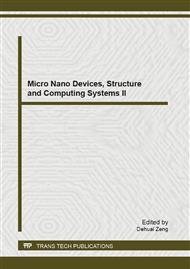p.61
p.69
p.74
p.79
p.85
p.90
p.94
p.98
p.103
Design and Test of High-g MEMS Accelerometer
Abstract:
For measuring the high-g impaction and overload of some conditions, a kind of high-g accelerometer was designed. Testing and analysis to the accelerometer was processed through launching projectile to penetrate concrete target. Four fixed end structure was adopted in the design of the high-g accelerometer and the chamfer was set in the bottom and top part of the beam to divert stress. It is learned that the sensitivity of the accelerometer is 0.1uv/g by calibration. A kind of deceleration measurement device was provided to test the performance of the accelerometer through penetration experiment over concrete target and the design of the measurement device and penetration experiment over concrete target was illustrated. The impaction characteristic of the accelerometer was tested and studied through penetration to the target. MATLAB software is used to analyze the influence of the filter cutoff frequency over the test result and the best cutoff frequency point was set at 6 kHz, under which the maximum penetration acceleration is up to 28526 g.
Info:
Periodical:
Pages:
85-89
Citation:
Online since:
March 2013
Authors:
Keywords:
Price:
Сopyright:
© 2013 Trans Tech Publications Ltd. All Rights Reserved
Share:
Citation:


